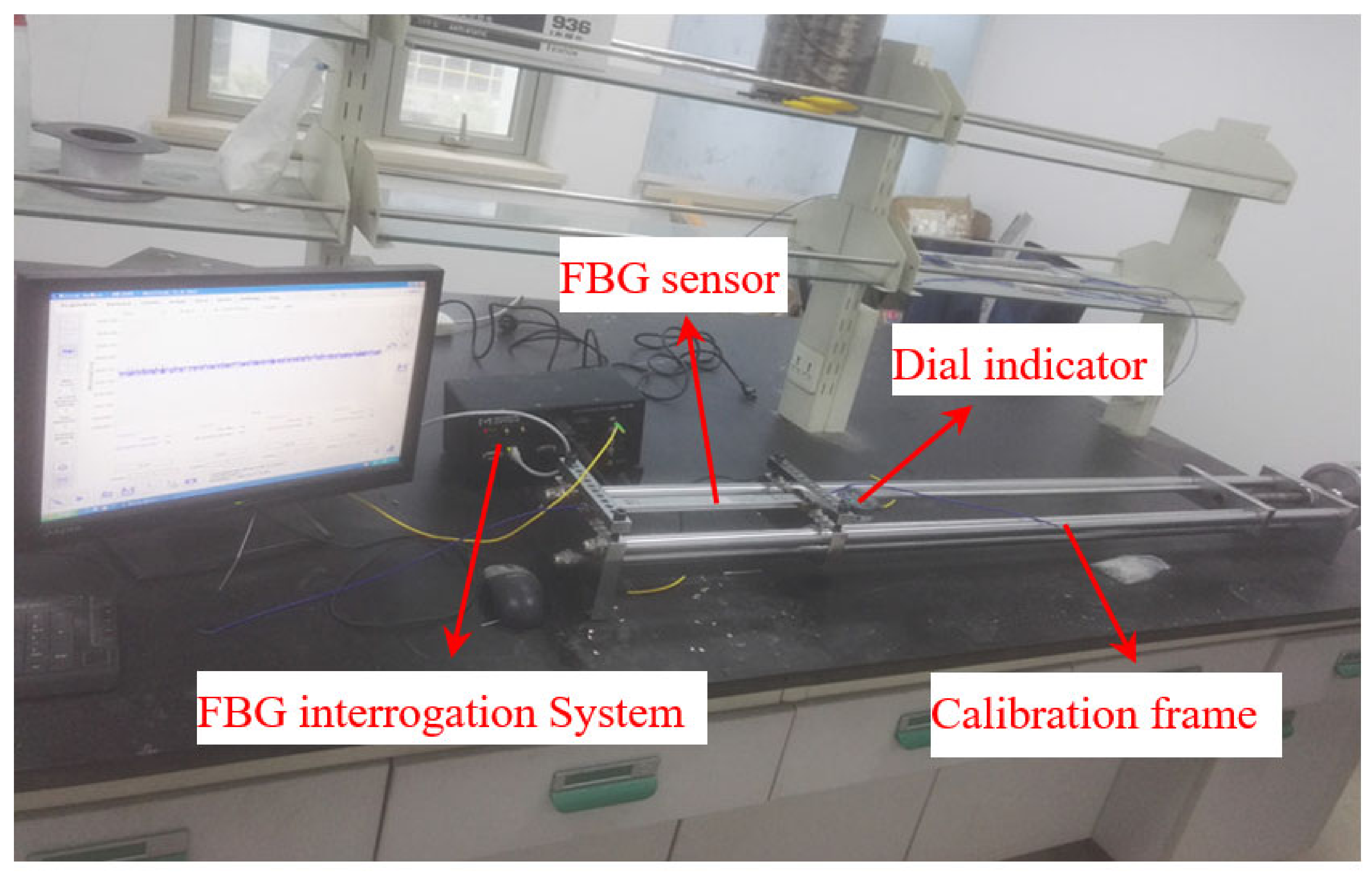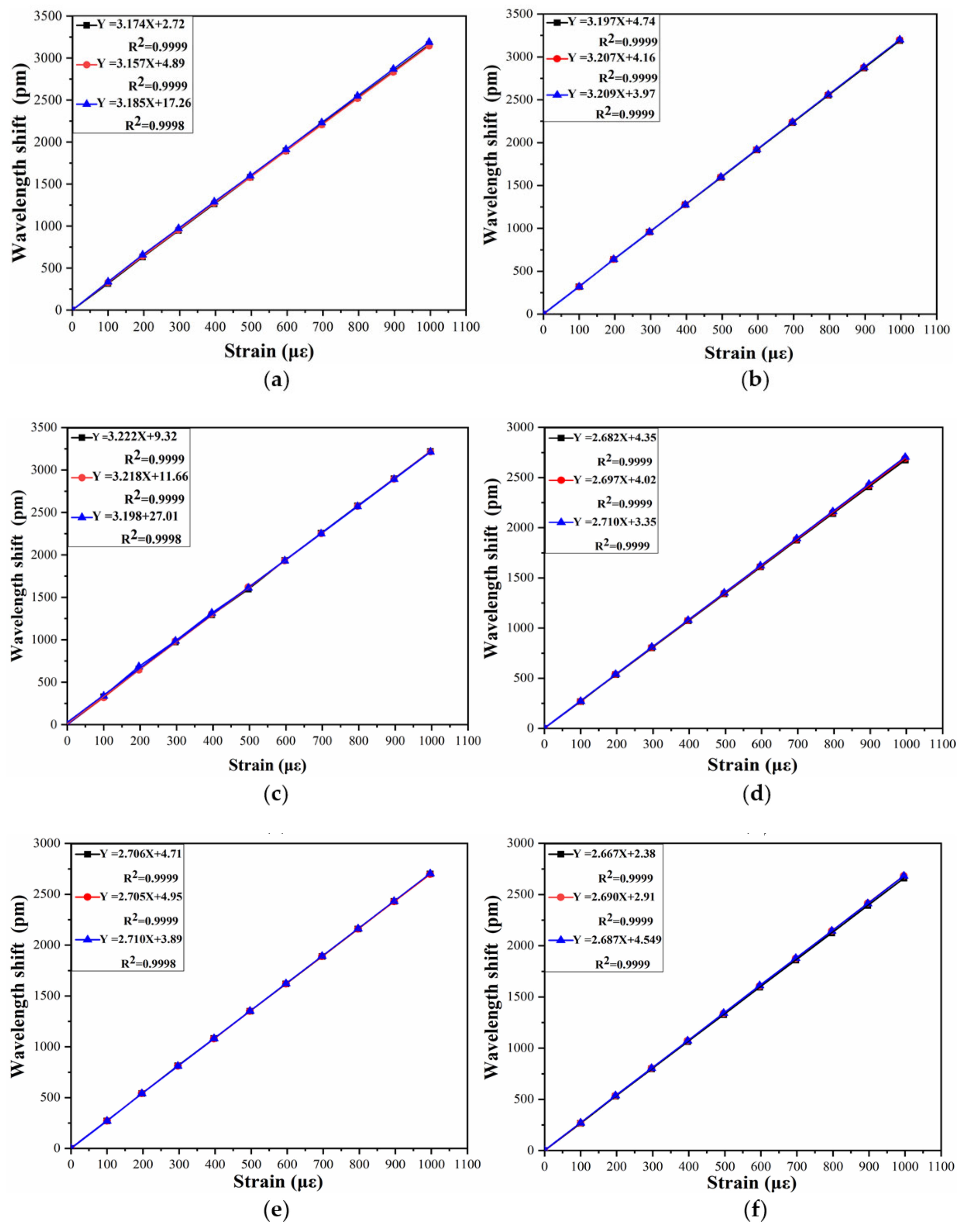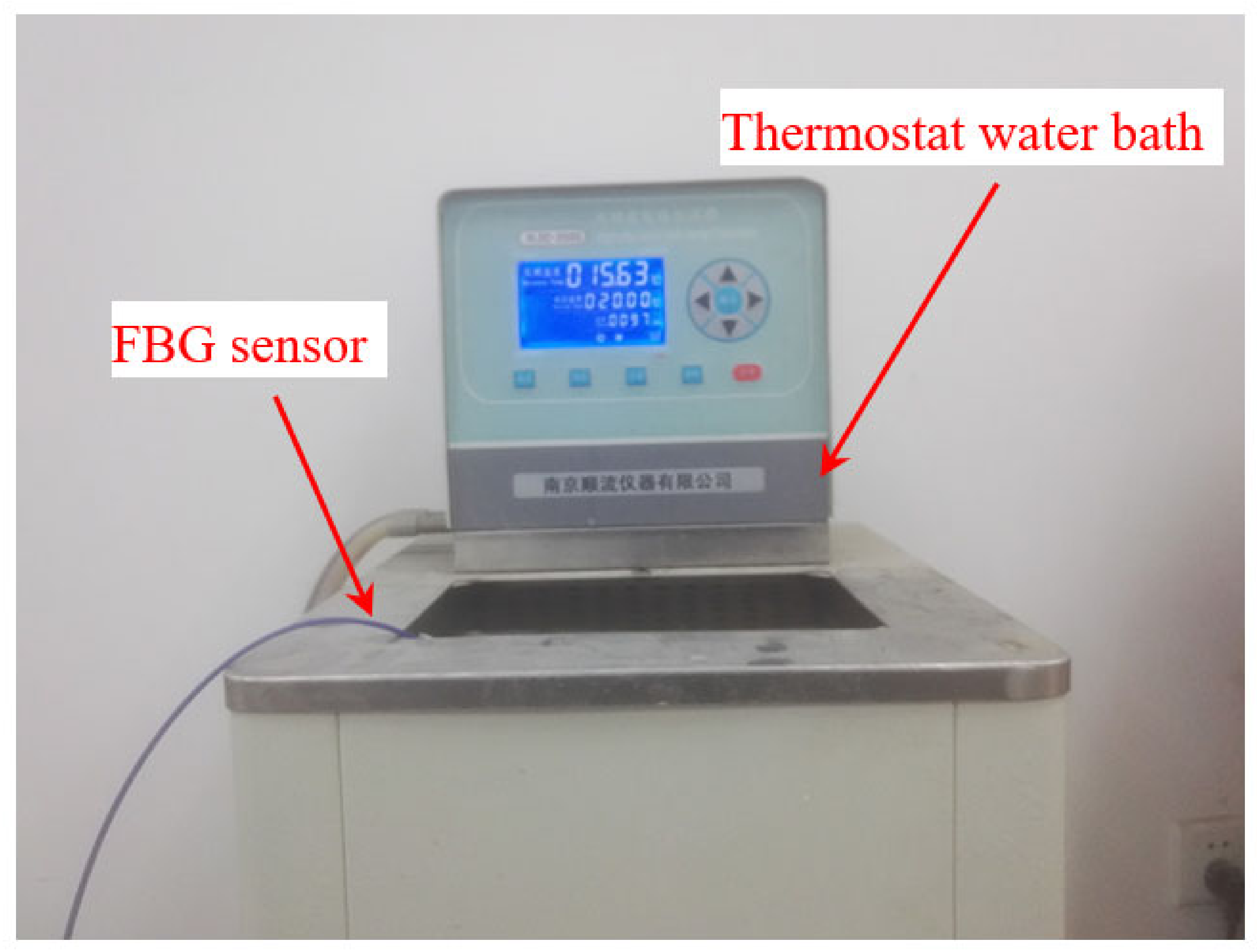Study of a Long-Gauge FBG Strain Sensor with Enhanced Sensitivity and Its Application in Structural Monitoring
Abstract
1. Introduction
2. Design of Sensitive FBG Strain Sensor
2.1. Design of the Sensor
2.2. Theoretical Analysis of the Sensitization
3. Experimental Study on Sensing Performance
3.1. Strain Sensing Calibration
3.2. Long-Term Sensing Stability
3.3. Temperature Sensing Calibration
3.4. Repeatable Performance Test
3.5. Study on Temperature Self-Compensation of Strain Sensor
4. Structural Monitoring of Strengthened RC Beams
4.1. Experimental Setup
4.2. Experimental Results
4.2.1. Comparison of Middle-Span Strain
4.2.2. Monitoring of the Development of Oblique Cracks
4.2.3. Monitoring of Shear Strain
5. Conclusions
- Compared with common commercial FBG sensors, the strain sensitivity coefficient of the proposed FBG sensor is greatly enhanced. Its strain sensitivity coefficient is 3.2 pm/με for the sensors with a gauge length of 30 cm, and the correlation linearity is greater than 0.999. Moreover, the design theory indicates that its strain sensitivity coefficient can be adjusted flexibly by changing its packaging method.
- The temperature test showed that temperature sensitivity coefficient of the FBG sensor is around three times that of the bare grating, and the relative error of different samples is less than 3%. The hysteresis experiment shows that the proposed sensor has stable performance.
- The proposed FBG strain sensors are used for a shear strengthening experiment on an RC beam to verify its working performance. The experimental results show that the strain change and crack development are well monitored by the FBG sensors during the loading process, and the beam strengthened by 2 cm ECC has the better effect.
Author Contributions
Funding
Institutional Review Board Statement
Informed Consent Statement
Data Availability Statement
Conflicts of Interest
References
- Mei, B.; Lucas, J.; Holé, S.; Lamarque, I.; Chéron, N. Excitation mode influence on vibrating wire sensor response. Exp. Mech. 2016, 56, 331–338. [Google Scholar] [CrossRef]
- Peng, L.; Jing, G.; Luo, Z.; Yuan, X.; Wang, Y.; Zhang, B. Temperature and Strain Correlation of Bridge Parallel Structure Based on Vibrating Wire Strain Sensor. Sensors 2020, 20, 658. [Google Scholar] [CrossRef] [PubMed]
- Ajovalasit, A. The measurement of large strains using electrical resistance strain gages. Exp. Tech. 2012, 36, 77–82. [Google Scholar] [CrossRef]
- Torres, B.; Payá-Zaforteza, I.; Calderón, P.A.; Adam, J.M. Analysis of the strain transfer in a new FBG sensor for structural health monitoring. Eng. Struct. 2011, 33, 539–548. [Google Scholar] [CrossRef]
- Li, S.Z.; Wu, Z.S. Development of distributed long-gage fiber optic sensing system for structural health monitoring. Struct. Health Monit. 2007, 6, 133–143. [Google Scholar] [CrossRef]
- Kocherla, A.; Subramaniam, K.V. Stress and damage localization monitoring in fiber-reinforced concrete using surface-mounted PZT sensors. Meas. Sci. Technol. 2019, 31, 024004. [Google Scholar] [CrossRef]
- Wan, C.; Hong, W.; Liu, J.; Wu, Z. Bridge assessment and health monitoring with distributed long-gauge FBG sensors. Int. J. Distrib. Sens. Netw. 2013, 9, 494260. [Google Scholar] [CrossRef]
- Chang, Y.J.; Yeh, C.H.; Chow, C.W. Reliability of stable fiber Bragg grating sensor system for monitoring temperature and strain individually. Meas. Sci. Technol. 2019, 30, 105108. [Google Scholar] [CrossRef]
- Malekzadeh, M.; Gul, M.; Kwon, I.B.; Catbas, N. An integrated approach for structural health monitoring using an in-house built fiber optic system and non-parametric data analysis. Smart. Struct. Syst. 2014, 14, 917–942. [Google Scholar] [CrossRef]
- Ren, L.; Chen, J.; Li, H.N. Design and application of a fiber Bragg grating strain sensor with enhanced sensitivity in the small-scale dam model. Smart Mater. Struct. 2009, 18, 035015. [Google Scholar] [CrossRef]
- Boateng, E.K.G.; Schubel, P.; Umer, R. Thermal isolation of FBG optical fibre sensors for composite cure monitoring. Sens. Actuator A Phys. 2019, 287, 158–167. [Google Scholar] [CrossRef]
- Mamidi, V.R.; Kamineni, S.; Ravinuthala, L.N.S.P.; Martha, M.; Madhuvarasu, S.S.; Thumu, V.R. High-temperature measurement using fiber Bragg grating sensor accompanied by a low-cost detection system. J. Appl. Remote Sens. 2015, 9, 094098. [Google Scholar] [CrossRef]
- Kerrouche, A.; Boyle, W.; Gebremichael, Y.; Sun, T.; Grattan, K.; Täljsten, B.; Bennitz, A. Field tests of fibre Bragg grating sensors incorporated into CFRP for railway bridge strengthening condition monitoring. Sens. Actuator A Phys. 2008, 148, 68–74. [Google Scholar] [CrossRef]
- Kerrouche, A.; Boyle, W.J.O.; Sun, T. Strain measurement using embedded fiber Bragg grating sensors inside an anchored carbon fiber polymer reinforcement prestressing rod for structural monitoring. IEEE Sens. J. 2009, 9, 1456–1461. [Google Scholar] [CrossRef]
- Li, S.; Wu, Z. Sensitivity enhancement of long-gage FBG sensors for macro-strain measurements. Struct. Health Monit. 2009, 8, 415–423. [Google Scholar]
- Shen, S.; Wu, Z.; Yang, C.; Wan, C.; Wu, G. An improved conjugated beam method for deformation monitoring with a distributed sensitive fiber optic sensor. Struct. Health Monit. 2010, 9, 361–378. [Google Scholar] [CrossRef]
- Li, R.; Chen, Y.; Tan, Y. Sensitivity enhancement of FBG-based strain sensor. Sensors 2018, 18, 1607. [Google Scholar] [CrossRef]
- Vahdati, N.; Wang, X.; Shiryayev, O. External Corrosion Detection of Oil Pipelines Using Fiber Optics. Sensors 2020, 20, 684. [Google Scholar] [CrossRef]
- Hong, W.; Wu, Z.S.; Yang, C.Q. Condition assessment of reinforced concrete beams using dynamic data measured with distributed long-gage macro-strain sensors. J. Sound Vibr. 2012, 331, 2764–2782. [Google Scholar] [CrossRef]
- Górriz, B.T.; García, P.C.; Payá-Zaforteza, I.J.; Maicas, S.S. Experimental and numerical analysis of a hybrid FBG long gauge sensor for structural health monitoring. Meas. Sci. Technol. 2014, 25, 125107. [Google Scholar] [CrossRef][Green Version]
- Yang, S.; Li, J.; Tang, Y.; Sun, M.; Gao, G.; Shi, B.; Dong, F.; Liu, X. Analysis of the performance of strain magnification using uniform rectangular cantilever beam with fiber Bragg gratings. Sens. Actuator A Phys. 2018, 273, 266–275. [Google Scholar] [CrossRef]
- Du, J.; He, Z. Sensitivity enhanced strain and temperature measurements based on FBG and frequency chirp magnification. Opt. Express 2013, 21, 27111–27118. [Google Scholar] [CrossRef]
- Guo, Y.; Kong, J.; Liu, H. Design and investigation of a reusable surface-mounted optical fiber Bragg grating strain sensor. IEEE Sens. J. 2016, 16, 8456–8462. [Google Scholar] [CrossRef]




















| Gauge Length L (cm) | L1 (cm) | L2 (cm) | Strain Enhancing Coefficient k | Theoretical Strain Coefficient K (pm/με) |
|---|---|---|---|---|
| 30 | 10 | 10 | 3 | 3.30 |
| 10 | 3 | 4 | 2.5 | 2.75 |
| Gauge Length L | 30 cm | 15 cm | ||||
|---|---|---|---|---|---|---|
| Sensor number | 1 | 2 | 3 | 4 | 5 | 6 |
| Wavelength (pm) | 1542 | 1545 | 1556 | 1530 | 1549 | 1565 |
Publisher’s Note: MDPI stays neutral with regard to jurisdictional claims in published maps and institutional affiliations. |
© 2021 by the authors. Licensee MDPI, Basel, Switzerland. This article is an open access article distributed under the terms and conditions of the Creative Commons Attribution (CC BY) license (https://creativecommons.org/licenses/by/4.0/).
Share and Cite
Yang, J.; Hou, P.; Yang, C.; Yang, N. Study of a Long-Gauge FBG Strain Sensor with Enhanced Sensitivity and Its Application in Structural Monitoring. Sensors 2021, 21, 3492. https://doi.org/10.3390/s21103492
Yang J, Hou P, Yang C, Yang N. Study of a Long-Gauge FBG Strain Sensor with Enhanced Sensitivity and Its Application in Structural Monitoring. Sensors. 2021; 21(10):3492. https://doi.org/10.3390/s21103492
Chicago/Turabian StyleYang, Jing, Peng Hou, Caiqian Yang, and Ning Yang. 2021. "Study of a Long-Gauge FBG Strain Sensor with Enhanced Sensitivity and Its Application in Structural Monitoring" Sensors 21, no. 10: 3492. https://doi.org/10.3390/s21103492
APA StyleYang, J., Hou, P., Yang, C., & Yang, N. (2021). Study of a Long-Gauge FBG Strain Sensor with Enhanced Sensitivity and Its Application in Structural Monitoring. Sensors, 21(10), 3492. https://doi.org/10.3390/s21103492






